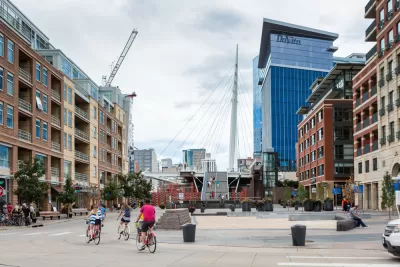The following interview, as published in the 4th Edition of the Planetizen Guide to Graduate Urban Planning Programs, features Peter Park, owner of Peter J Park, LLC and an instructor at the University of Colorado-Denver and Harvard University.

The interview featured here was originally published in the 4th Edition of the Planetizen Guide to Graduate Urban Planning Programs to inform potential graduate students of the immense potential of the study and practice of planning. In Peter Park's case, our interview focused on a career defined by leadership roles in Denver and Milwaukee, which can boast of some of the most ambitious planning efforts in recent decades, as well as a successful transition into the private sector and academia. We hope you'll read for this article for lessons in the many shapes a successful career in planning can take.
You recently left the public sector, where you working for the city of Denver. What kind of work did you do in the public sector, and what factors influenced your decision to make the jump?
I worked in the public sector for 16 years—about eight years in Milwaukee and eight years in Denver—and I had the great fortune of working with great mayors in great cities with very talented and dedicated planners. We led a lot of innovative work in advancing and promoting the profession of planning and urban design. That ranged from overseeing the zoning code updates for both of those cities to remapping both of those cities. Completing either of those projects once is a pretty big deal. Doing it twice is a big deal too.
 I oversaw the planning for the removal of the Park East freeway in downtown Milwaukee and the transformation of a former brownfield site along the Milwaukee River into a new mixed-use neighborhood called the Beerline B. Both of these projects are shaped by form-based codes. In Denver, we introduced a citywide form-based zoning code. We also worked on transit oriented development in Denver—setting up a strategic approach to capitalize on new transit investments, like the planning and design of Union Station. I feel very fortunate to have been involved in these and many other significant projects in those 16 years; we accomplished a lot.
I oversaw the planning for the removal of the Park East freeway in downtown Milwaukee and the transformation of a former brownfield site along the Milwaukee River into a new mixed-use neighborhood called the Beerline B. Both of these projects are shaped by form-based codes. In Denver, we introduced a citywide form-based zoning code. We also worked on transit oriented development in Denver—setting up a strategic approach to capitalize on new transit investments, like the planning and design of Union Station. I feel very fortunate to have been involved in these and many other significant projects in those 16 years; we accomplished a lot.
We had a transition in Denver to a new mayor. The mayor I worked for became the governor of Colorado. I felt it might be a good time to apply to the Loeb Fellowship at the Harvard Graduate School of Design, which I’ve always wanted to do. So I applied, and I was very fortunate to be selected. It was a big decision to do that at that point in my career, and I’m really happy I did.
When I did my fellowship I was looking at the possibilities for form-based codes and the need of American cities to update their zoning codes. I also looked at removing freeways from cities, like we did in Milwaukee, and what the opportunities are for that happening more often, especially given our infrastructure challenges around the country, our financial conditions, and the fact that highways and cities don’t work well together. I also did research on different techniques for community engagement, especially because that whole process and method has changed considerably in recent years, with the advent of different kinds of social media and other techniques and technologies.
What kind of projects have you been working on in your new consulting practice?
After my fellowship, I decided that I wanted to go out on my own and start a practice. I’ve got a lot of good contacts from across the country, and I was invited to be on a team with Code Studio to do the Los Angeles Zoning Code. That project, called Re:Code LA is well underway. I was also invited to be on the team to redo the zoning code for Austin, Texas with Opticos Design Inc.
I just finished up some work in Houston—that American city that doesn’t have zoning. It also doesn’t have a plan, so I worked for just over six months with an advocacy group for planning in Houston, the Mayor’s Office, and the Planning Department to scope out what a general plan for Houston might include. It’s Houston, so it can’t be done like anyone else does it, but I think that we identified a way to start the city toward preparing their first general plan, within the city’s timeframe and the level of effort that they want to put into it.
I’m also doing some work internationally. I participated in workshops on transit oriented development in Mexico City and Chennai, India. I was recently in Sydney, Australia meeting with mayors of various cities in New South Wales, around Sydney, about planning.
Going back to the private sector has been quite good. I’m happy to do work I’m interested in and dealing with people who want to explore innovations in practice.
How do you describe the regulatory powers or planning to someone with a vague idea of the concepts underlying planning and urbanism? Why do these tools of the planning trade matter?
The simplest way that I can put it is that whether they are well planned or not, cities will happen. Even if you’re not planning, you still get development. Things still happen. People still show up.
The idea of planning, and engaged community planning, is a way of getting what you want. That’s the simplest way I can put it. It’s a question of whether the built environment, the natural environment, the economy of the place, and the overall character and personality of the place is accidental, or whether there’s a deliberate effort at defining civic value and sense of place.
There was a time in our American cities when planning focused on solving problems and regulating things to control for the things that people didn’t want or things they feared. It wasn’t a very good way to describe what we aspire to. Today there are just so many better techniques for a) engaging people, b) visualizing potential futures, and c) creating administrative and regulatory systems that match the aspirations of a collective of people. It’s a very exciting time, quite frankly, in planning.
It’s also a challenging time. There are political agendas against planning. As planners or prospective planners we need to constantly find ways to describe the value of what we do as planners.
Given that you’ve worked work in the private sector and the public sector, what skills should students focus on if they know which sector they want to work in?
My background is primarily in architecture and urban design. Then later, in planning school, I focused on policy. As a teacher, I’ve had students from all different backgrounds, and I’ve always had this bias that design is really important. Design is important, but if there’s one thing that folks who might be interested in planning ought to focus on is an understanding of global economics—what is at the core of how cities form, how cities improve, or how they fail to thrive?
Also important are skills in engaging people—finding ways to harness technologies to broaden conversations and to create transparency in the planning process. We have so many great visualization techniques for explaining potential future incomes that you don’t have to have years and years of formal training in design to be incredibly capable at creating those visualizations.
Given your role as an instructor at Harvard University and the University of Colorado-Denver, what is your advice for students who might be interested in an academic career in the study of planning?
From my own experience, I find today that planning students are very interested in practice. There are actually very few students who are interested in a purely academic career—but if they are, they will be better equipped if they have significant practical experience.
What are the most important things you learned in your graduate school program?
In graduate school I had the opportunity to do a joint degree program: a Master of Architecture and Master of Urban Planning. That was an ideal background. I was exposed to the policy side of the world as well as an emphasis in something I am very interested in, which is design, architecture, and physical planning. There are many programs now that have a joint degree similar to that. It prepared me well for where the profession itself has progressed—to a higher emphasis on physical planning and design.
Particularly at the University of Wisconsin, there was an emphasis on methods on the planning side: planning policy analysis, decision analysis, and strong analytical and decision-making methods. That was a good way to exercise both sides of my brain, because I had architectural and urban design studios at the same time. So I feel very fortunate to have participated in a program like that, which also had great faculty who were involved in practice. I had a chance to work with one of my faculty members, Larry Witzling, while I was in school and after I graduated, I joined him in business as a partner. That connection to academia and real-world practice was very valuable. I also have to credit Dean Greenstreet at UW-Milwaukee and Dean Gelernter at UC-Denver for their leadership in supporting such connections. I think the academic programs at these schools benefit greatly from strong engagement with professionals in practice.
In a general sense, what advice would you have for a person who is considering applying for planning school right now?
Go into it with as broad a base as you can. Planning as a profession really bridges politics, sociology, economics, engineering, and architecture. Ultimately you’re talking about policies that affect the physical environment, people’s lives, and our collective future.

Planetizen Federal Action Tracker
A weekly monitor of how Trump’s orders and actions are impacting planners and planning in America.

The Simple Legislative Tool Transforming Vacant Downtowns
In California, Michigan and Georgia, an easy win is bringing dollars — and delight — back to city centers.

San Francisco's School District Spent $105M To Build Affordable Housing for Teachers — And That's Just the Beginning
SFUSD joins a growing list of school districts using their land holdings to address housing affordability challenges faced by their own employees.

In More Metros Than You’d Think, Suburbs are Now More Expensive Than the City
If you're moving to the burbs to save on square footage, data shows you should think again.

The States Losing Rural Delivery Rooms at an Alarming Pace
In some states, as few as 9% of rural hospitals still deliver babies. As a result, rising pre-term births, no adequate pre-term care and "harrowing" close calls are a growing reality.

The Small South Asian Republic Going all in on EVs
Thanks to one simple policy change less than five years ago, 65% of new cars in this Himalayan country are now electric.
Urban Design for Planners 1: Software Tools
This six-course series explores essential urban design concepts using open source software and equips planners with the tools they need to participate fully in the urban design process.
Planning for Universal Design
Learn the tools for implementing Universal Design in planning regulations.
Smith Gee Studio
City of Charlotte
City of Camden Redevelopment Agency
City of Astoria
Transportation Research & Education Center (TREC) at Portland State University
US High Speed Rail Association
City of Camden Redevelopment Agency
Municipality of Princeton (NJ)





























